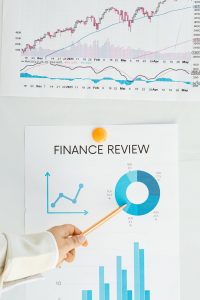Have a Question?
T01 – What is a Technical Indicator?
DISCLAIMER:
None of the information communicated here is financial advice. Digital Coin Trader is not a financial advisor and this content and material is presented for informational purposes only. Under no circumstances shall Digital Coin Trader be held liable for any damages arising out of, or in connection with, your access or use of our material.
Introduction
The goal of any trader is to make money. As a trader, your objective is to correctly anticipate the direction a price will go, up or down, and then buy or sell an asset to profit off of that change in price. The only way you can make money is if you can guess correctly whether a price is going to move in a particular direction, and then buy and sell an asset based on that prediction. Buying an asset and then selling it for more money, nets the trader a positive profit. But it’s not quite that easy. Most trades incur a transaction cost, which the exchanges or brokers charge to support the transaction. If the trader has gained more profit from his transaction than the fees for performing the trade, then the trader has made a profit. Conversely, by buying an asset and then selling it for less money, or not selling it for more than the cost of the transactions, then the trader has a negative profit. They have lost money.
But how do you know which direction an asset will move?

Truthfully, no one knows which direction a price will move before it occurs, not even the best traders. If it were that easy everyone would be millionaire traders! So traders use everything they can that might help them make a successful determination. To improve your chances of determining the direction a price will go, you need to analyze everything about the asset you are trading.
What is Trading Analysis?

Trading Analysis typically comes in two forms:
- Technical Analysis – Technical Analysis uses mathematical equations or algorithms, to provide statistical analysis of an asset’s price, usually over time.
- Fundamental Analysis – Fundamental Analysis studies the positive or negative news or information about an asset
More on Technical Analysis
As mentioned above, Technical Analysis involves collecting data, then applying mathematical equations or algorithms, to provide statistical analysis of an asset’s price, usually over time.
There are numerous technical indicators to help a trader determine which direction an asset or market is moving, to help them make smarter decisions about which direction the price is going to move in the future.
The market itself does not move based on technical indicators, rather the technical indicators help us better understand the market as it is moving.
What technical analysis is:
Technical analysis is mathematic, not emotional or spiritual. It is based on values and calculations.
Technical Analysis is a tool. It does not give you the answer, it is a tool to help the trader better make a judgment on which direction the market might move.
It is “lagging,” displaying what has already happened. Data needs to be gathered and calculated to provide some sort of indicator that shows the user, visually, the result of the calculation
What technical analysis is not:
It is not perfect, or the “answer” – No technical analysis is 100% right all the time. The market can easily go against the indicator at any time and often does.
It is not the only part of the overall analysis of an asset. A trader must know fundamentals as well to make a more educated determination.
technical analysis is only part of the “picture,” only giving a tiny slice of information about an asset.
What is a Technical Indicator?
A technical indicator is a tool that uses technical analysis to generate a visual representation of calculations depicted on a chart.
A technical indicator can be a line, a dot, an arrow, a value, a signal, or any number of symbols to give the user information about an asset’s market activity
Most traders and trading systems utilize several indicators layered together to form a larger strategy.
DCT uses over a dozen indicators in its default strategy to determine signals, far more than a human is capable of calculating and considering in their head
Closing Statement
Technical indicators are powerful mathematical calculations performed much faster than a human is capable of. They convey that information in a visual representation that the user can visually see and understand if trained to read it. For more information on specific Technical Indicators, please read about them in the Technical Indicators section of the Help menu: https://digitalcointrader.io/index.php/knowledge-base-faq/ which will provide you with several of the most common indicators and a basic description of how they work, and how they can be applied.